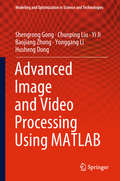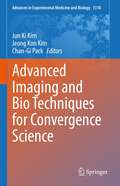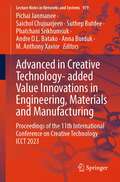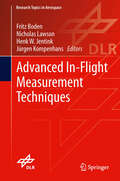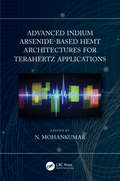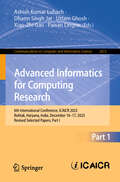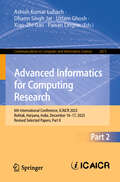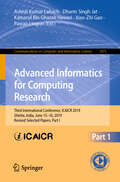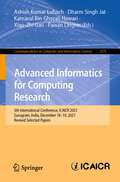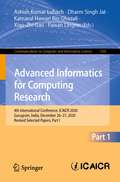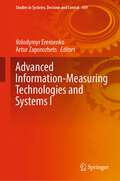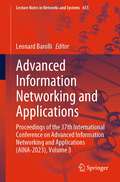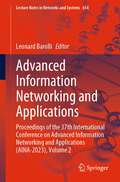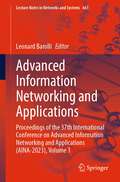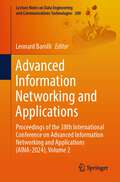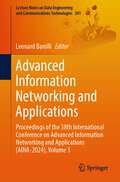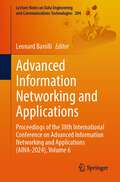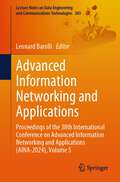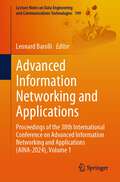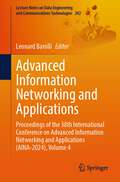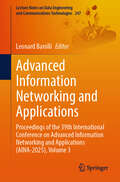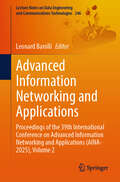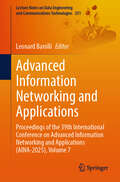- Table View
- List View
Advanced Hybrid Nanomaterials for Energy Storage (Emerging Materials and Technologies)
by Won-Chun Oh Suresh SagadevanIntegrating nanotechnology and sustainable energy frontiers, Advanced Hybrid Nanomaterials for Energy Storage explores the groundbreaking field of material design at the nanoscale for next‑generation energy storage solutions. This comprehensive text delves into the synthesis, characterization, and optimization of hybrid nanomaterials developed by combining the advantageous properties of diverse materials. This diverse range of materials includes metal oxides, carbon nanostructures, biopolymers, and functionalized surfaces. These materials have the potential to revolutionize energy storage technologies such as batteries and supercapacitors due to their synergistic properties and innovative applications.FEATURES Explores the latest advances in hybrid nanomaterial design for energy storage applications Discusses the benefits of combining different materials at the nanoscale range, exhibiting their combined properties which significantly outperform those of individual components Defines the various types of hybrid nanomaterials, including metal oxide/carbon nanocomposites, metal‑doped composites, and biopolymer‑based materials Focuses on the real‑world implications of hybrid nanomaterials in battery electrodes, supercapacitor electrodes, and other energy storage devices Summarizes the important role of these materials in transitioning to a clean and sustainable energy environment This book serves as an important resource for both industry professionals and academic researchers and is ideal for scientists and engineers working in advanced materials for energy storage applications.
Advanced Image and Video Processing Using MATLAB (Modeling and Optimization in Science and Technologies #12)
by Shengrong Gong Chunping Liu Yi Ji Baojiang Zhong Yonggang Li Husheng DongThis book offers a comprehensive introduction to advanced methods for image and video analysis and processing. It covers deraining, dehazing, inpainting, fusion, watermarking and stitching. It describes techniques for face and lip recognition, facial expression recognition, lip reading in videos, moving object tracking, dynamic scene classification, among others. The book combines the latest machine learning methods with computer vision applications, covering topics such as event recognition based on deep learning,dynamic scene classification based on topic model, person re-identification based on metric learning and behavior analysis. It also offers a systematic introduction to image evaluation criteria showing how to use them in different experimental contexts. The book offers an example-based practical guide to researchers, professionals and graduate students dealing with advanced problems in image analysis and computer vision.
Advanced Image Processing in Magnetic Resonance Imaging (Signal Processing and Communications)
by Luigi Landini Vincenzo Positano Maria Filomena SantarelliThe popularity of magnetic resonance (MR) imaging in medicine is no mystery: it is non-invasive, it produces high quality structural and functional image data, and it is very versatile and flexible. Research into MR technology is advancing at a blistering pace, and modern engineers must keep up with the latest developments. This is only possible with a firm grounding in the basic principles of MR, and Advanced Image Processing in Magnetic Resonance Imaging solidly integrates this foundational knowledge with the latest advances in the field.Beginning with the basics of signal and image generation and reconstruction, the book covers in detail the signal processing techniques and algorithms, filtering techniques for MR images, quantitative analysis including image registration and integration of EEG and MEG techniques with MR, and MR spectroscopy techniques. The final section of the book explores functional MRI (fMRI) in detail, discussing fundamentals and advanced exploratory data analysis, Bayesian inference, and nonlinear analysis. Many of the results presented in the book are derived from the contributors' own work, imparting highly practical experience through experimental and numerical methods.Contributed by international experts at the forefront of the field, Advanced Image Processing in Magnetic Resonance Imaging is an indispensable guide for anyone interested in further advancing the technology and capabilities of MR imaging.
Advanced Imaging and Bio Techniques for Convergence Science (Advances in Experimental Medicine and Biology #1310)
by Jun Ki Kim Jeong Kon Kim Chan-Gi PackThis book is a wide-ranging guide to advanced imaging techniques and related methods with important applications in translational research or convergence science as progress is made toward a new era in integrative healthcare. Conventional and advanced microscopic imaging techniques, including both non-fluorescent (i.e., label-free) and fluorescent methods, have to date provided researchers with specific and quantitative information about molecules, cells, and tissues. Now, however, the different imaging techniques can be correlated with each other and multimodal methods developed to simultaneously obtain diverse and complementary information. In addition, the latest advanced imaging techniques can be integrated with non-imaging techniques such as mass spectroscopic methods, genome editing, organic/inorganic probe synthesis, nanomedicine, and drug discovery. The book will be of high value for researchers in the biological and biomedical sciences or convergence science who need to use these multidisciplinary and integrated techniques or are involved in developing new analytical methods focused on convergence science.
Advanced in Creative Technology- added Value Innovations in Engineering, Materials and Manufacturing: Proceedings of the 11th International Conference on Creative Technology ICCT 2023 (Lecture Notes in Networks and Systems #979)
by Pichai Janmanee Saichol Chujuarjeen Suthep Butdee Phatchani Srikhumsuk Andre D.L. Batako Anna Burduk M. Anthony XaviorThe 11th International Conference on Creative Technology (ICCT2023): To Added Value Innovations in Engineering, Materials and Manufacturing was held in Rajamangala University of Technology Krungthep, 2 Nanglinchi Road, Thungmahamek, Sathorn, Bangkok, Thailand, between July 20 and 22, 2023. The conference was organized by three universities from three countries, namely Rajamangala University of Technology Krungthep (RMUTK, Thailand), Vellore Institute of Technology (VIT, India), and Liverpool John Moores University (LJMU, England). The conference aimed to give an opportunity for students, government organizations, private sectors, and universities to exchange experiences in advances in materials and manufacturing, simulation, automation, optimization of production processes, production management, maintenance, simulation, Industry 4.0, AI, and robotics. This book presents a collection of 58 peer-reviewed papers. The organizers received 61 contributions from 12 countries around the world. After a thorough peer-review process, the committee accepted 33 papers for conference proceedings prepared by 142 authors from 11 countries (acceptance rate of around 54%).
Advanced In-Flight Measurement Techniques (Research Topics in Aerospace)
by Fritz Boden Henk W. Jentink Jürgen Kompenhans Nicholas LawsonThe book presents a synopsis of the main results achieved during the 3 year EU-project "Advanced Inflight Measurement Techniques (AIM)" which applied advanced image based measurement techniques to industrial flight testing. The book is intended to be not only an overview on the AIM activities but also a guide on the application of advanced optical measurement techniques for future flight testing. Furthermore it is a useful guide for engineers in the field of experimental methods and flight testing who face the challenge of a future requirement for the development of highly accurate non-intrusive in-flight measurement techniques.
Advanced Indium Arsenide-Based HEMT Architectures for Terahertz Applications
by N. MohankumarHigh electron mobility transistor (HEMT) has better performance potential than the conventional MOSFETs. Further, InAs is a perfect candidate for the HEMT device architecture owing to its peak electron mobility. Advanced Indium Arsenide-based HEMT Architectures for Terahertz Applications characterizes the HEMT based on InAs III-V material to achieve outstanding current and frequency performance. This book explains different types of device architectures available to enhance performance including InAs-based single gate (SG) HEMT and double gate (DG) HEMT. The noise analysis of InAs-based SG and DG-HEMT is also discussed. The main goal of this book is to characterize the InAs device to achieve terahertz frequency regime with proper device parameters. Features: Explains the influence of InAs material in the performance of HEMTs and MOS-HEMTs. Covers novel indium arsenide architectures for achieving terahertz frequencies Discusses impact of device parameters on frequency response Illustrates noise characterization of optimized indium arsenide HEMTs Introduces terahertz electronics including sources for terahertz applications. This book is of special interest to researchers and graduate students in Electronics Engineering, High Electron Mobility Transistors, Semi-conductors, Communications, and Nanodevices.
Advanced Informatics for Computing Research: 6th International Conference, ICAICR 2023, Rohtak, Haryana, India, December 16–17, 2023, Revised Selected Papers, Part I (Communications in Computer and Information Science #2072)
by Ashish Kumar Luhach Dharm Singh Jat Uttam Ghosh Xiao-Zhi Gao Pawan LingrasThis two-volume set constitutes the revised selected papers of the 6th International Conference on Advanced Informatics for Computing Research, ICAICR 2023 held in Rohtak, Haryana, India, in December 16–17, 2023.The 58 full papers presented in these proceedings were carefully reviewed and selected from 225 submissions. They are organized in topical sections as follows: Volume number 2072: Artificial Intelligence; Data Science; Human computer interaction (HCI), Machine Learning.Volume number 2073: Machine Learning; Security and Privacy.
Advanced Informatics for Computing Research: 6th International Conference, ICAICR 2023, Rohtak, Haryana, India, December 16–17, 2023, Revised Selected Papers, Part II (Communications in Computer and Information Science #2073)
by Ashish Kumar Luhach Dharm Singh Jat Uttam Ghosh Xiao-Zhi Gao Pawan LingrasThis two-volume set constitutes the revised selected papers of the 6th International Conference on Advanced Informatics for Computing Research, ICAICR 2023 held in Rohtak, Haryana, India, in December 16–17, 2023.The 58 full papers presented in these proceedings were carefully reviewed and selected from 225 submissions. They are organized in topical sections as follows: Volume number 2072: Artificial Intelligence; Data Science; Human computer interaction (HCI), Machine Learning.Volume number 2073: Machine Learning; Security and Privacy.
Advanced Informatics for Computing Research: Third International Conference, ICAICR 2019, Shimla, India, June 15–16, 2019, Revised Selected Papers, Part I (Communications in Computer and Information Science #1075)
by Ashish Kumar Luhach Dharm Singh Jat Kamarul Bin Ghazali Hawari Xiao-Zhi Gao Pawan LingrasThis two-volume set (CCIS 1075 and CCIS 1076) constitutes the refereed proceedings of the Third International Conference on Advanced Informatics for Computing Research, ICAICR 2019, held in Shimla, India, in June 2019. The 78 revised full papers presented were carefully reviewed and selected from 382 submissions. The papers are organized in topical sections on computing methodologies; hardware; information systems; networks; software and its engineering.
Advanced Informatics for Computing Research: 5th International Conference, ICAICR 2021, Gurugram, India, December 18–19, 2021, Revised Selected Papers (Communications in Computer and Information Science #1575)
by Ashish Kumar Luhach Dharm Singh Jat Kamarul Bin Ghazali Hawari Xiao-Zhi Gao Pawan LingrasThis volume constitutes selected and revised papers of the 5th International Conference on Advanced Informatics for Computing Research, ICAICR 2021, held in Gurugram, India, in December 2021. The 17 revised full papers and 6 short papers presented were carefully reviewed and selected from 306 submissions. The papers targeted state-of-the-art as well as emerging topics pertaining to advanced informatics for computing research and its implementation for engineering applications.
Advanced Informatics for Computing Research: 4th International Conference, ICAICR 2020, Gurugram, India, December 26–27, 2020, Revised Selected Papers, Part I (Communications in Computer and Information Science #1393)
by Ashish Kumar Luhach Dharm Singh Jat Kamarul Hawari Bin Ghazali Xiao-Zhi Gao Pawan LingrasThis two-volume set (CCIS 1393 and CCIS 1394) constitutes selected and revised papers of the 4th International Conference on Advanced Informatics for Computing Research, ICAICR 2020, held in Gurugram, India, in December 2020. The 34 revised full papers and 51 short papers presented were carefully reviewed and selected from 306 submissions. The papers are organized in topical sections on computing methodologies; hardware; networks; security and privacy.
Advanced Information-Measuring Technologies and Systems I (Studies in Systems, Decision and Control #439)
by Volodymyr Eremenko Artur ZaporozhetsThe book presents the main scientific directions and issues of research conducted in the Department of Information and Measurement Technologies at the National Technical University of Ukraine "Ihor Sikorskyi Kyiv Polytechnic Institute". The presented results cover almost all scientific directions related to information and measurement technologies—metrological support of measurement channels of information and measurement systems, methods of reproducing units of electric circuit parameters, development of specialized information and measurement systems, mathematical methods of processing measurement information, models of formation of information signals and fields, statistical diagnostic methods, information support of testing, and calibration laboratories.
Advanced Information Networking and Applications: Proceedings of the 37th International Conference on Advanced Information Networking and Applications (AINA-2023), Volume 3 (Lecture Notes in Networks and Systems #655)
by Leonard BarolliNetworks of today are going through a rapid evolution and there are many emerging areas of information networking and their applications. Heterogeneous networking supported by recent technological advances in low power wireless communications along with silicon integration of various functionalities such as sensing, communications, intelligence and actuations are emerging as a critically important disruptive computer class based on a new platform, networking structure and interface that enable novel, low cost and high volume applications. Several of such applications have been difficult to realize because of many interconnections problems. To fulfill their large range of applications different kinds of networks need to collaborate and wired and next generation wireless systems should be integrated in order to develop high performance computing solutions to problems arising from the complexities of these networks. This volume covers the theory, design and applications of computer networks, distributed computing and information systems.The aim of the volume “Advanced Information Networking and Applications” is to provide latest research findings, innovative research results, methods and development techniques from both theoretical and practical perspectives related to the emerging areas of information networking and applications.
Advanced Information Networking and Applications: Proceedings of the 37th International Conference on Advanced Information Networking and Applications (AINA-2023), Volume 2 (Lecture Notes in Networks and Systems #654)
by Leonard BarolliNetworks of today are going through a rapid evolution and there are many emerging areas of information networking and their applications. Heterogeneous networking supported by recent technological advances in low power wireless communications along with silicon integration of various functionalities such as sensing, communications, intelligence and actuations are emerging as a critically important disruptive computer class based on a new platform, networking structure and interface that enable novel, low cost and high volume applications. Several of such applications have been difficult to realize because of many interconnections problems. To fulfill their large range of applications different kinds of networks need to collaborate and wired and next generation wireless systems should be integrated in order to develop high performance computing solutions to problems arising from the complexities of these networks. This volume covers the theory, design and applications of computer networks, distributed computing and information systems. The aim of the volume “Advanced Information Networking and Applications” is to provide latest research findings, innovative research results, methods and development techniques from both theoretical and practical perspectives related to the emerging areas of information networking and applications.
Advanced Information Networking and Applications: Proceedings of the 37th International Conference on Advanced Information Networking and Applications (AINA-2023), Volume 1 (Lecture Notes in Networks and Systems #661)
by Leonard BarolliNetworks of today are going through a rapid evolution and there are many emerging areas of information networking and their applications. Heterogeneous networking supported by recent technological advances in low power wireless communications along with silicon integration of various functionalities such as sensing, communications, intelligence and actuations are emerging as a critically important disruptive computer class based on a new platform, networking structure and interface that enable novel, low cost and high volume applications. Several of such applications have been difficult to realize because of many interconnections problems. To fulfill their large range of applications different kinds of networks need to collaborate and wired and next generation wireless systems should be integrated in order to develop high performance computing solutions to problems arising from the complexities of these networks. This volume covers the theory, design and applications of computer networks, distributed computing and information systems.The aim of the volume “Advanced Information Networking and Applications” is to provide latest research findings, innovative research results, methods and development techniques from both theoretical and practical perspectives related to the emerging areas of information networking and applications.
Advanced Information Networking and Applications: Proceedings of the 38th International Conference on Advanced Information Networking and Applications (AINA-2024), Volume 2 (Lecture Notes on Data Engineering and Communications Technologies #200)
by Leonard BarolliNetworks of today are going through a rapid evolution and there are many emerging areas of information networking and their applications. Heterogeneous networking supported by recent technological advances in low power wireless communications along with silicon integration of various functionalities such as sensing, communications, intelligence, and actuations are emerging as a critically important disruptive computer class based on a new platform, networking structure and interface that enable novel, low-cost and high-volume applications. Several of such applications have been difficult to realize because of many interconnection problems. To fulfill their large range of applications different kinds of networks need to collaborate and wired and next generation wireless systems should be integrated in order to develop high performance computing solutions to problems arising from the complexities of these networks. This book covers the theory, design and applications of computer networks, distributed computing, and information systems. The aim of the book “Advanced Information Networking and Applications” is to provide latest research findings, innovative research results, methods and development techniques from both theoretical and practical perspectives related to the emerging areas of information networking and applications.
Advanced Information Networking and Applications: Proceedings of the 38th International Conference on Advanced Information Networking and Applications (AINA-2024), Volume 3 (Lecture Notes on Data Engineering and Communications Technologies #201)
by Leonard BarolliNetworks of today are going through a rapid evolution and there are many emerging areas of information networking and their applications. Heterogeneous networking supported by recent technological advances in low power wireless communications along with silicon integration of various functionalities such as sensing, communications, intelligence, and actuations are emerging as a critically important disruptive computer class based on a new platform, networking structure and interface that enable novel, low-cost and high-volume applications. Several of such applications have been difficult to realize because of many interconnection problems. To fulfill their large range of applications different kinds of networks need to collaborate and wired and next generation wireless systems should be integrated in order to develop high performance computing solutions to problems arising from the complexities of these networks. This book covers the theory, design and applications of computer networks, distributed computing, and information systems. The aim of the book “Advanced Information Networking and Applications” is to provide latest research findings, innovative research results, methods and development techniques from both theoretical and practical perspectives related to the emerging areas of information networking and applications.
Advanced Information Networking and Applications: Proceedings of the 38th International Conference on Advanced Information Networking and Applications (AINA-2024), Volume 6 (Lecture Notes on Data Engineering and Communications Technologies #204)
by Leonard BarolliNetworks of today are going through a rapid evolution and there are many emerging areas of information networking and their applications. Heterogeneous networking supported by recent technological advances in low power wireless communications along with silicon integration of various functionalities such as sensing, communications, intelligence, and actuations are emerging as a critically important disruptive computer class based on a new platform, networking structure and interface that enable novel, low-cost and high-volume applications. Several of such applications have been difficult to realize because of many interconnection problems. To fulfill their large range of applications different kinds of networks need to collaborate and wired and next generation wireless systems should be integrated in order to develop high performance computing solutions to problems arising from the complexities of these networks. This book covers the theory, design and applications of computer networks, distributed computing, and information systems. The aim of the book “Advanced Information Networking and Applications” is to provide latest research findings, innovative research results, methods and development techniques from both theoretical and practical perspectives related to the emerging areas of information networking and applications.
Advanced Information Networking and Applications: Proceedings of the 38th International Conference on Advanced Information Networking and Applications (AINA-2024), Volume 5 (Lecture Notes on Data Engineering and Communications Technologies #203)
by Leonard BarolliThis book covers the theory, design and applications of computer networks, distributed computing and information systems. Networks of today are going through a rapid evolution and there are many emerging areas of information networking and their applications. Heterogeneous networking supported by recent technological advances in low-power wireless communications along with silicon integration of various functionalities such as sensing, communications, intelligence and actuations is emerging as a critically important disruptive computer class based on a new platform, networking structure and interface that enable novel, low-cost and high-volume applications. Several such applications have been difficult to realize because of many interconnection problems. To fulfill their large range of applications, different kinds of networks need to collaborate and wired and next-generation wireless systems should be integrated in order to develop high-performance computing solutions to problems arising from the complexities of these networks. This book aims to provide the latest research findings, innovative research results, methods and development techniques from both theoretical and practical perspectives related to the emerging areas of information networking and applications.
Advanced Information Networking and Applications: Proceedings of the 38th International Conference on Advanced Information Networking and Applications (AINA-2024), Volume 1 (Lecture Notes on Data Engineering and Communications Technologies #199)
by Leonard BarolliNetworks of today are going through a rapid evolution and there are many emerging areas of information networking and their applications. Heterogeneous networking supported by recent technological advances in low power wireless communications along with silicon integration of various functionalities such as sensing, communications, intelligence, and actuations are emerging as a critically important disruptive computer class based on a new platform, networking structure and interface that enable novel, low-cost and high-volume applications. Several of such applications have been difficult to realize because of many interconnection problems. To fulfill their large range of applications different kinds of networks need to collaborate and wired and next generation wireless systems should be integrated in order to develop high performance computing solutions to problems arising from the complexities of these networks. This book covers the theory, design and applications of computer networks, distributed computing, and information systems. The aim of the book “Advanced Information Networking and Applications” is to provide latest research findings, innovative research results, methods and development techniques from both theoretical and practical perspectives related to the emerging areas of information networking and applications.
Advanced Information Networking and Applications: Proceedings of the 38th International Conference on Advanced Information Networking and Applications (AINA-2024), Volume 4 (Lecture Notes on Data Engineering and Communications Technologies #202)
by Leonard BarolliThe aim of the book is to provide latest research findings, innovative research results, methods, and development techniques from both theoretical and practical perspectives related to the emerging areas of information networking and applications. Networks of today are going through a rapid evolution, and there are many emerging areas of information networking and their applications. Heterogeneous networking supported by recent technological advances in low power wireless communications along with silicon integration of various functionalities such as sensing, communications, intelligence, and actuations is emerging as a critically important disruptive computer class based on a new platform, networking structure, and interface that enable novel, low-cost and high-volume applications. Several of such applications have been difficult to realize because of many interconnection problems. To fulfill their large range of applications different kinds of networks need to collaborate and wired and next-generation wireless systems should be integrated in order to develop high-performance computing solutions to problems arising from the complexities of these networks. This book covers the theory, design, and applications of computer networks, distributed computing, and information systems.
Advanced Information Networking and Applications: Proceedings of the 39th International Conference on Advanced Information Networking and Applications (AINA-2025), Volume 3 (Lecture Notes on Data Engineering and Communications Technologies #247)
by Leonard BarolliNetworks of today are going through a rapid evolution and there are many emerging areas of information networking and their applications. Heterogeneous networking supported by recent technological advances in low power wireless communications along with silicon integration of various functionalities such as sensing, communications, intelligence and actuations are emerging as a critically important disruptive computer class based on a new platform, networking structure and interface that enable novel, low-cost and high-volume applications. Several of such applications have been difficult to realize because of many interconnection problems. To fulfill their large range of applications different kinds of networks need to collaborate and wired and next generation wireless systems should be integrated in order to develop high performance computing solutions to problems arising from the complexities of these networks. This volume covers the theory, design and applications of computer networks, distributed computing and information systems. The aim of the volume &“Advanced Information Networking and Applications&” is to provide latest research findings, innovative research results, methods and development techniques from both theoretical and practical perspectives related to the emerging areas of information networking and applications.
Advanced Information Networking and Applications: Proceedings of the 39th International Conference on Advanced Information Networking and Applications (AINA-2025), Volume 2 (Lecture Notes on Data Engineering and Communications Technologies #246)
by Leonard BarolliNetworks of today are going through a rapid evolution and there are many emerging areas of information networking and their applications. Heterogeneous networking supported by recent technological advances in low power wireless communications along with silicon integration of various functionalities such as sensing, communications, intelligence and actuations are emerging as a critically important disruptive computer class based on a new platform, networking structure and interface that enable novel, low-cost and high-volume applications. Several of such applications have been difficult to realize because of many interconnection problems. To fulfill their large range of applications different kinds of networks need to collaborate and wired and next generation wireless systems should be integrated in order to develop high performance computing solutions to problems arising from the complexities of these networks. This volume covers the theory, design and applications of computer networks, distributed computing and information systems.The aim of the volume &“Advanced Information Networking and Applications&” is to provide latest research findings, innovative research results, methods and development techniques from both theoretical and practical perspectives related to the emerging areas of information networking and applications.
Advanced Information Networking and Applications: Proceedings of the 39th International Conference on Advanced Information Networking and Applications (AINA-2025), Volume 7 (Lecture Notes on Data Engineering and Communications Technologies #251)
by Leonard BarolliNetworks of today are going through a rapid evolution and there are many emerging areas of information networking and their applications. Heterogeneous networking supported by recent technological advances in low power wireless communications along with silicon integration of various functionalities such as sensing, communications, intelligence and actuations are emerging as a critically important disruptive computer class based on a new platform, networking structure and interface that enable novel, low-cost and high-volume applications. Several of such applications have been difficult to realize because of many interconnection problems. To fulfill their large range of applications different kinds of networks need to collaborate and wired and next generation wireless systems should be integrated in order to develop high performance computing solutions to problems arising from the complexities of these networks. This volume covers the theory, design and applications of computer networks, distributed computing and information systems. The aim of the volume &“Advanced Information Networking and Applications&” is to provide latest research findings, innovative research results, methods and development techniques from both theoretical and practical perspectives related to the emerging areas of information networking and applications.

